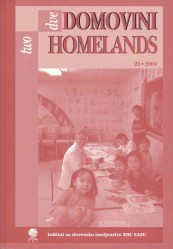SLOVENES IN AUSTRALIAN TASMANIA
Abstract
Already the first scientific definition of culture as cited by Godina (1998: 84), “culture is a complex entirety, which contains knowledge, religion, art, morality, laws, customs and any other capacities and habits a human acquires as member of the society” (Tylor 1994/1871: 1), emphasizes besides learned habits and social character of culture, its transferability, transitiveness in diachronic and synchronic perspectives. The element of transitiveness is common to all later definitions of culture. In the article Slovenes in Tasmania, which is a summary of my diploma titled Ohranjanje etnične identitete Slovencev na avstralski Tasmaniji (Preserving ethnic identity of Slovenes in Australian Tasmania), I deal with the very problem of transferring and preserving culture in the sense of preservation of ethnic identity of Slovenes in Tasmania. In order to collect ethnographic material, I decided for fieldwork among Slovenes in Tasmania. From November 14th to December 19th 2002, I interviewed 32 informants and recorded 20 radio cassettes or 26.5 hours of material. After my return, the material was of fundamental significance as it directed the processing of data and the choosing of theories. Thus, my analysis began with answers and not with questions; facts defined theories and not vice versa. In the article, I focused on the ethnographic part of my diploma work. I have summed up the findings on life of Slovene emigrants in Tasmania in individual chapters and subchapters. The first pages thus give a short survey on migrations to Tasmania, and the present ethnic structure of the inhabitants. Follow a series of facts such as number, age, place of birth, place of residence, and duration of staying in Tasmania, education, work, marital status, and family life. The last part is issues that demand a more thorough analysis: the reason for coming to Tasmania, its experiencing then and today, language, knowledge of English language and learning, use of Slovene language then and today, transfer of Slovene language to children, names of children, mutual socializing and expressing appurtenance on community level, expressing appurtenance on personal level, contacts with Slovenia, comprehension of home – Slovenia or Australia.
In studying cases as mine, a compromise is logical between what should be ideal to research, and what is realistically feasible and still scientifically correct. Because of extensiveness of matter, I did not deal in particular with the history of migrations in Australia and Tasmania. Data on present ethnic structure in Tasmania are also merely informative. As well, I did not deal with surveying of emigration from Slovene ethnic space. I also know that if we wanted to study the entire process of transfer of Slovene culture on the one side and inclusion in Australian culture on the other, we should include in the research at least their descendants, that is, the second generation. It would be interesting to include in the research the “returnees” – those who have after a many-years stay in Tasmania returned to Slovenia. A comparison between different generations of emigrants was not carried out as the generation in Tasmania is by age relatively homogeneous.
The interviews have been recorded in as much as possible a relaxed atmosphere in their homes. There because I could observe their lodgings (that is – whether I would find something that would prove a Slovene lives there). Usually, the interviews that were on average over 50 minutes long were performed along some Slovene food and drink, listening to the music; it was their choice to show me what they wanted to. As a rule, I was in contact with my informants for at least a few days. My concluding thoughts I can summarize the following: the basic condition for a diachronic and synchronic transfer of a certain culture is the physical existence of its representatives. On the basis of data acquired during fieldwork in Tasmania I can summarize that because of relative old age of the informants and no influx of new emigrants to this insular state in the last ten years, there will be no Slovenes in Australian Tasmania in less than 50 years. For that reason too, the present article and the diploma work are one among rare but not sole records on a group of Slovenes in Tasmania.
Downloads
References
Bučar, Bojko, Zlatko Šabič, Milan Brglez (2000). Navodila za pisanje: seminarske naloge in diplomska dela. Ljubljana: Fakulteta za družbene vede.
Čebulj Sajko, Breda (1999). Etnologija in izseljenstvo. Ljubljana: Slovensko etnološko društvo.
Čebulj Sajko, Breda (2000). Razpotja izseljencev. Ljubljana: Založba ZRC Slovenija.
Godina, Vesna (1998). Izbrana poglavja iz zgodovine antropoloških teorij. Ljubljana: Fakulteta za družbene vede.
Južnič, Stane (1983). Lingvistična antropologija. Ljubljana: Dopisna delavska univerza Univerzum
Južnič, Stane (1987). Antropologija. Ljubljana: Državna založba Slovenije.
Južnič, Stane (1989). Politična kultura. Maribor: Založba Obzorja Maribo
Južnič, Stane (1993). Identiteta. Ljubljana: Fakulteta za družbene vede.
Klinar, Peter (1976). Mednarodne migracije. Maribor: Založba Obzorja Maribor.
Lukšič Hacin, Marina (1995). Ko tujina postane dom. Ljubljana: Znanstveno in pu¬ blicistično središče.
Lukšič Hacin, Marina (1999). Multikulturalizem. Ljubljana: ZRC SAZU
Šabec, Nada (1995). Halfpa pu. Ljubljana: Škuc.
Šterk, Kannen (1998). O težavah z mano. Ljubljana: Scripta.
Zalokar, Jurij (1991). Mavrična kača. Radovljica: Didakta
Zupančič, Jernej (1999). Slovenci v Avstriji. Ljubljana: Inštitut za geografijo.
Downloads
Published
How to Cite
Issue
Section
License

This work is licensed under a Creative Commons Attribution-NonCommercial-NoDerivatives 4.0 International License.
Authors guarantee that the work is their own original creation and does not infringe any statutory or common-law copyright or any proprietary right of any third party. In case of claims by third parties, authors commit their self to defend the interests of the publisher, and shall cover any potential costs.
More in: Submission chapter





